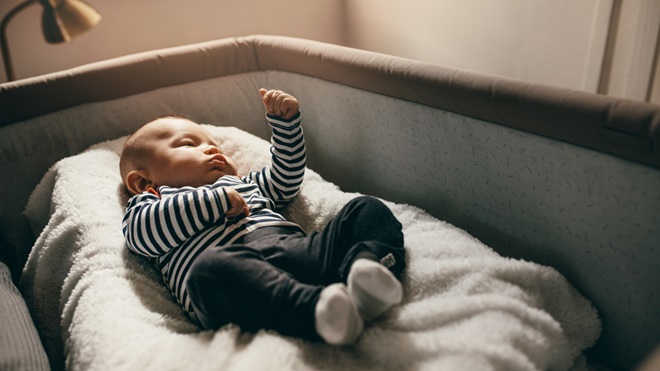Bassinets are popular because they're smaller than a cot and can be placed beside your bed during baby's early months. Bedside sleepers are another option – these attach to the side of your bed with one side fully or partly opened, allowing you to reach over and tend to your baby in the night.
But despite a safe sleeping environment being crucial at this stage of your infant's life, there are still no Australian standards for bassinets or bedside sleepers. So how does CHOICE recommend models we think are safe?
On this page:
Our expert testers
With more than 20 years of experience, our expert testers are the bees' knees of children's product testing. They've seen all the brands and varying bassinet configurations on the market, and have put many of them to the test.
Our experts sit on the Australian Standards committees for children's products and we report our findings to regulators and other industry stakeholders.
How we choose what we test
Most of the time, our priority is to test what you'll see in stores. That's why many of our bassinets come from brands you'll see in mainstream nursery or department stores. However, bedside sleepers are a relatively new trend in Australia, and we're interested in checking the safety of these products too – even if the brand isn't a household name yet.
We don't test Moses baskets because they don't tend to pass our strict breathability, depth or stability requirements.
To come up with our list we survey manufacturers to find out about their range of models and we take member feedback on board. Our buyers then purchase products like a regular consumer would, either instore or online. This is to make sure the products we receive haven't been 'tweaked' in any way for better performance.
How we test bassinets
We're still waiting for an Australian standard for bassinets and bedside sleepers, but our experts know what to look for when it comes to safety and we've devised our own in-house test procedures. We've based our test methods on various existing standards for similar children's products such as cots and folding cots.
There are also overseas standards to draw upon, including a US safety standard for bedside sleepers, F2903-13, which we've tailored to meet Australian requirements.
Bassinets
Here are the main safety issues we assess when testing bassinets.
- Small objects which could become loose and pose a choking hazard.
- Sharp corners, edges and points.
- Breathable zones on all four sides, such as mesh walls at sleeping level. Any breathable zone needs to be at least 100mm high at the top surface of the mattress – this is to prevent suffocation if an infant happens to roll to the side (and some bassinets have bouncing or rocking mechanisms which could cause baby to move, too). Any non-breathable areas around the bassinet which may form part of its structure need to be less than 60mm wide. Many bassinets we test that provide breathable zones still fail our requirements.
- To prevent falls, bassinets must be at least 250mm deep to be fully recommended. This is a strict condition, and is based on the existing folding cot standard (bassinet mode). Even bassinets that are slightly under this requirement won't get a complete pass, as falls can occur when a baby leans or crawls over the sides, and you don't want to find out the hard way that baby has learned to do that. However, models that are still at least 225mm deep won't be penalised as harshly as one that's much shallower.
- Horizontal and vertical strength is assessed to see if the bassinet will collapse when force of around 100 Newtons (approximately 10kg) is applied at various points for 10 seconds. Similarly we conduct a vertical static load test by placing a 40kg mass on the bassinet for one minute.
- Stability of construction.
- Entrapment hazards between any moving components.
- Head, limb and finger entrapments in openings.
- Mattress firmness (tested to the Australian cot mattress firmness method, AS/NZS 8811.1:2013).
Bedside sleepers
Bedside sleepers can be used in bassinet mode, so we subject them to the same tests as bassinets (above).
Bedside sleepers have at least one side that can be either partly or fully opened. Suitable adult bed heights need to be clearly stated on the packaging and instructions. We check to make sure there are no suffocation or entrapment hazards between the bedside sleeper and adult bed, or at any opened area of the bedside sleeper itself.
Ease of use
This score doesn't yet feature for all bassinets we've tested, so it's published separately to the CHOICE Expert Rating. It involves ease of assembling and installing, and ease of removing any fabric parts for washing.
Test criteria explained
We rate children's products a bit differently to other tests, due to the strong interest in safety. We rate performance according to whether they pass or fail major tests. Products with a CHOICE Expert Rating (our overall score) of 60% and above pass key safety tests.
- No failures: 100%
- Very minor failures: 80%
- One minor failure and no serious failures: 65%
- Multiple minor failures but no serious failure: 60%
- One serious failure: 40%
- More than one serious failure: 20%
We're on your side
For more than 60 years, we've been making a difference for Australian consumers. In that time, we've never taken ads or sponsorship.
Instead we're funded by members who value expert reviews and independent product testing.
With no self-interest behind our advice, you don't just buy smarter, you get the answers that you need.
You know without hesitation what's safe for you and your family. And our recent sunscreens test showed just how important it is to keep business claims in check.
So you'll never be alone when something goes wrong or a business treats you unfairly.
Learn more about CHOICE membership today
Stock images: Getty, unless otherwise stated.



